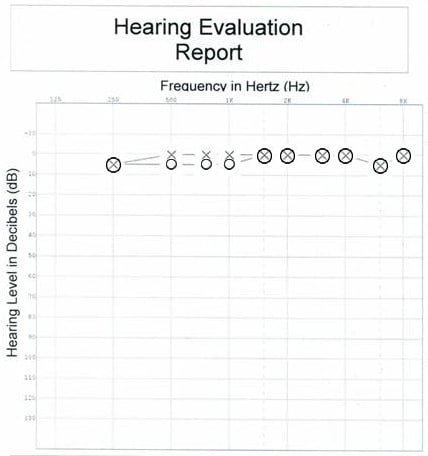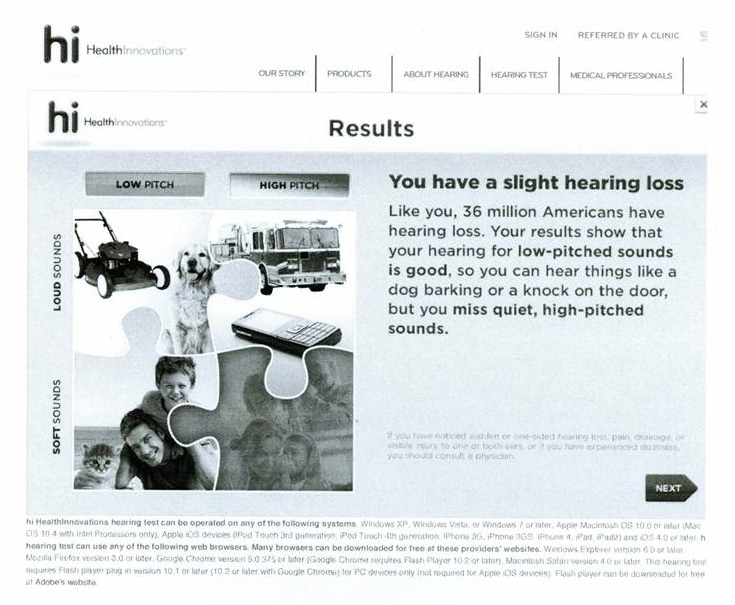This post continues last week’s post about online retailing of hearing devices. Today’s post analyzes the current set up by United Health Care (UHC) which recently contracted with hi HealthInnovations to deliver devices. At present a hearing exam can be taken on the website. This hearing test consists of two tones (high/low) delivered to the right ear and the the left ears, with testees adjusting the volume through their own headphones to “barely hear” and “hear comfortably”. The barely-hear level is checked a few times for accuracy. Following the tones there is a series of questions using an “always…never” scale. This assessment is not unlike informal communication surveys used by practitioners. Recommendations follow successful completion of the test and the communication assessment. The word “hearing aid” is never used, except in testimonials on the website. If you wonder why, go back to last week’s blog to see the FDA’s definitional difference between PSAPs and hearing aids. PSAPs are supposed to be for those who do not have a audiometrically-confirmed hearing loss; those people are better fitted according to the FDA by hearing aids. Ironically, although the word hearing “aid” is not used very much in this new retail effort, both UHC and hi HealthInnovations are upfront in stating that their target is those with hearing loss.
I decided to take the online test myself. I have my current audiogram (done in my office) included here.  We do biologic tests on all of our equipment quite often and my ears are used the most. I took the test online and completed it with and without the headphones, on the assumption that most but not all individuals have headphones. Additionally, I wanted to compare the two sets of results.
We do biologic tests on all of our equipment quite often and my ears are used the most. I took the test online and completed it with and without the headphones, on the assumption that most but not all individuals have headphones. Additionally, I wanted to compare the two sets of results.
Some readers may be concerned that I bring an inherent bias to the test, but I did go to “barely hear” and “comfortable” in all of the tone presentations to the best of my ability. I answered the questions and again did my best to answer to my real world experiences. After I conducted the test with and without the headphones, I received recommendation seen below. It was recommended that I seek hearing help because I have trouble in the higher frequencies. All hearing device styles except power were shown to me. I did not go past the recommendation stage of hearing devices. I do not know whether a medical clearance waiver is requested at the end, but I doubt it since these instruments are presented as PSAPs.
The problem my results suggest is that the hi HealthInnovations test produces false positives because I do not have a hearing loss. Another issue can be ear wax. An observed hearing loss could just be due to cerumen in the ear. If a person did move forward on purchasing this product the end result could be feedback because of ear wax. Due to the plug and feedback, the person does not hear better nor can they use the device. That purchaser can become upset and disillusioned with any associated product and can delay getting treatment or a simple cerumen removal. The purchaser could also buy a product they do not need.
A more serious problem-expressed repeatedly in past criticisms of waivers and automatic tests– is the possibility of overlooking a serious medical condition underlying the measured hearing loss. What if they have a conductive or retrocochlear component? What if they think that the two tone test is as accurate as a full diagnostic hearing evaluation, with otoscopy and either ignore the symptoms with or without a purchase from online? Watching for medical indications and medication interactions is very important in hearing health care. If we focus on the product all of this will be missed.
In my 12 years as a business owner I have only once had a confirmed diagnosis of an acoustic tumor. In 2001 we offered free hearing screenings and found an asymmetrical hearing loss but no other known or reported audiovestibular symptoms. RC was referred at that time but she did not follow up. We were able to follow up with her and have a full evaluation in 2003 and she did report that mild tinnitus started recently and we made an ENT appointment for her at the end of our appointment. An acoustic schwannoma was found and she had radiation treatment and two surgeries since. I see RC around town and she thanks us every time for finding this through our testing. This is what is going to be missed if online tests are allowed as a true hearing exam.







The United Healthcare hearing benefit is less about hearing and much more about building membership for their Medicare Advantage plan. It’s no coincidence that the news of the new benefit came out at the same time as the yearly open enrollment period. We can all quibble with the value of the hi HearingInnovations online hearing test and whether their products qualify as hearing aids or PSAPs, but all that really matters is what the 65+ consumer thinks of their products, mode of service and cost of goods. Rather than rail against United Healthcare it might make more sense for every hearing dispenser to look at his or her own value proposition for the hearing impaired consumer.
I agree it comes down to the experience we give those we fit. It is how we handle this new entry into the market though that will mark our future as dispensers. If we do not say anything about this type of testing then could this become the norm in the future? There is so much more than “can you hear the tone” and “how does that sound?” We can work to make ourselves better at fitting, but also to stand up to what we feel is right.
The hearingtest portion appears to be very similar to Beltone First Step.
Also, note that the hi HearingInnovations hearing aids are programmable: That means somebody with a HiPRO box (or similar) has access to fine tune it: Since I don’t see one offered for sale, then that means the user has to go to a professional for fine tuning.
Dan Schwartz,
Editor, The Hearing Blog
Dan, thank you for pointing that out. We can show why it can be more beneficial to go to a licensed professional. If we have the HiPRO would we need special software?
If it walks like a hearing aid and quacks like a hearing aid, it must be a hearing aid!